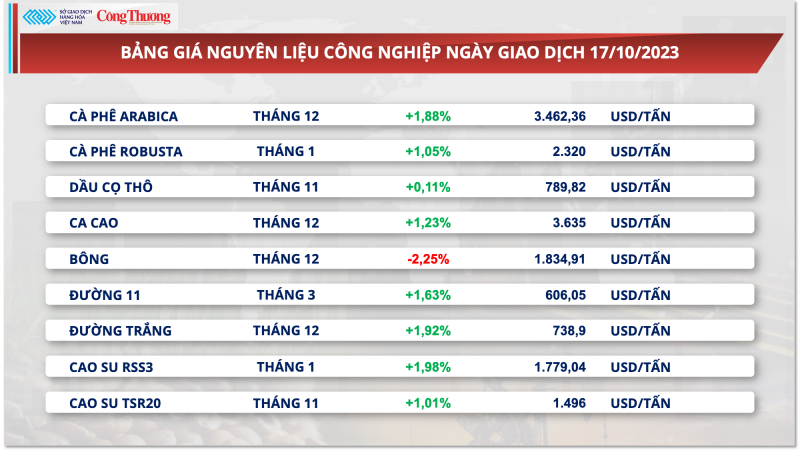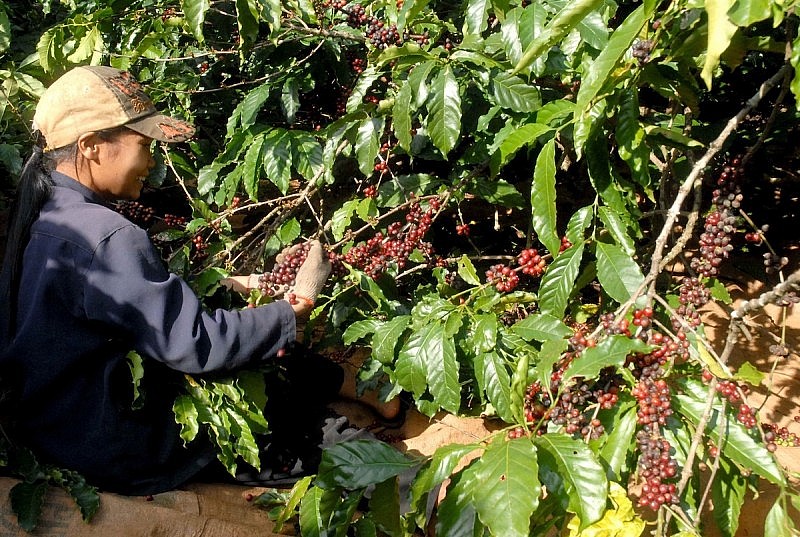According to data from Vietnam Commodity Exchange (MXV), at the end of the trading session on October 17, the prices of two coffee products improved despite coffee exports in Brazil showing many positive signs in the first half of October. Accordingly, Arabica prices increased by 1. 88% after a decline at the beginning of the week. Robusta price extended its upward momentum for the 4th consecutive session when closing at a price 1.05% higher than the reference.
| Coffee prices increased in yesterday’s trading session |
The Brazilian Foreign Trade Secretariat (Secex) said that in the first two weeks of October, Brazil exported an average of 13,300 tons of coffee per day, an increase of 26.4% compared to the average for the whole month of October 2022. The increase in Brazil’s coffee supply comes from a nearly 7% increase in 2023 output compared to last year.
However, in the weekly report of the Brazilian government’s Crop Supply Agency (CONAB), Arabica prices in this country are fluctuating around 800 Real/bag, 30% lower than the same period last year. . Low prices cause many suppliers to choose to stay out of the market, temporarily causing confusion about supply.
For Robusta coffee, world Robusta coffee prices are being supported by heavy rains in the Central Highlands coffee region of Vietnam, slowing down the harvest of new crops. Meanwhile, coffee inventories on the Intercontinental Commodity Exchange (ICE) continue to decline regardless of volume coffee export Conilon Robusta from Brazil has increased by 329.3% in the first 3 months of the new 2023/2024 crop year.
|
Robusta coffee prices around the world are being supported by heavy rains in Vietnam’s Central Highlands coffee region, slowing down the harvest of new crops. |
Data shows that Robusta coffee inventory on ICE Futures as of October 13 has decreased by 2,360 tons, or 5.62% compared to a week earlier, to 39,670 tons (about 661,167 bags), a level Minimum two months. This is a factor that supports the price of Robusta – also a popular type of coffee in Vietnam.
Regarding the type of exported coffee, data from the Import-Export Department shows that processed coffee export turnover increased by 22% in the first 7 months of this year to 448.7 million USD, accounting for 17% of total turnover. coffee export while this rate in the same period last year was 15%.
According to experts, to achieve the export turnover target of 5-6 billion USD by 2030, the coffee industry must increase processing rates (decaffeinated, roasted, instant coffee…), improve quality. quantity of green coffee beans because there is not much room left to increase output by increasing the area. Not to mention, increasing production also has the risk of oversupply, pulling coffee prices down.
The position of Vietnamese coffee beans has increased in recent years because Vietnam has made great improvements in varieties and cultivation as well as many well-invested coffee processing factories with international standards. In addition to coffee beans, ripe coffee pods are also produced into a high-end product, cascara tea, which is popular in the market. Mr. Phan Minh Thong – General Director of Phuc Sinh Joint Stock Company said that Phuc Sinh is about to build an additional cascara tea factory in Son La, with a capacity of 100 tons/year, 10 times the current factory to meet increased orders. .
The promotion of coffee processing has helped many Vietnamese coffee chains increase their value and continuously export abroad. Not stopping at exporting raw and processed coffee, at the end of September, Trung Nguyen Legend officially opened its first coffee shop in the US in the form of franchising. Previously, this coffee brand had success with 2 stores in China, a new step forward for the Vietnamese coffee brand abroad.
In early October, Cao Nguyen Coffee Service Joint Stock Company (owner of the Highlands Coffee chain) started construction of the Cao Nguyen Coffee Roasting Factory project, with an investment of up to 500 billion VND, meeting international standards with the ambition put Vietnamese roasted coffee on the world map. The factory has a capacity of nearly 10,000 tons of coffee/year in the first phase and can increase to 75,000 tons/year in the next phase.
Highlands Coffee currently has nearly 700 stores in Vietnam and more than 50 stores in the Philippines as of September 2023. Highlands coffee products are present in the Philippines, USA, Canada, China, Czech Republic, Malaysia, Maldives, and England.


